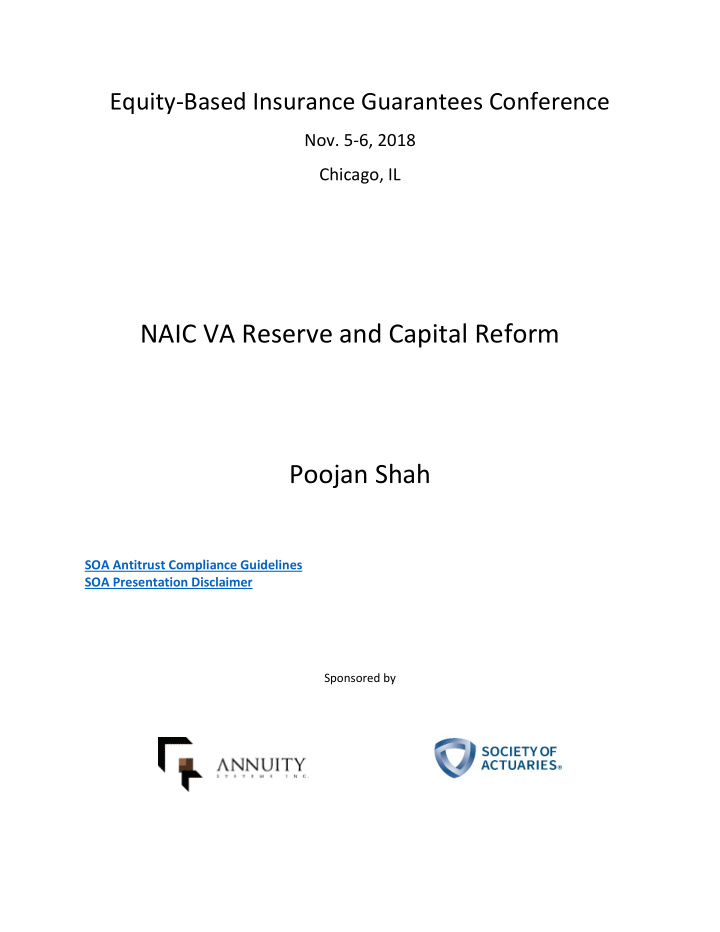



Equity-Based Insurance Guarantees Conference Nov. 5-6, 2018 Chicago, IL NAIC VA Reserve and Capital Reform Poojan Shah SOA Antitrust Compliance Guidelines SOA Presentation Disclaimer Sponsored by
NAIC VA Reserve and Capital Reform 2018 EBIG Conference November 6 th , 2018 (1030 – 1200 hours) Poojan Shah, FSA, CERA, CFA, MAAA
Background • The current AG43 (reserving) and C3P2 (capital) standards are complex and have several shortcomings. Application of the standards across companies is inconsistent Introduces significant volatility in funding requirement Motivates the use of captives • The NAIC has commissioned an initiative to identify and propose changes to the current frameworks. The goal is to satisfy the following overarching objectives: Ensure robustness of funding requirements Promote sound risk management Promote comparability across insurers and products Preserve current statutory construct where feasible Minimize implementation complexity 2
Current VA Framework Overview CTE 90 CTE 90 CTE 70 CTE 70 Adjusted Hedging Best Efforts Hedging Best Efforts Hedging Adjusted Hedging Weighted Weighted Avg. Avg. Min E-factor = 30% C3P2 C3P2 AG43 AG43 Stochastic Standard Scenario Standard Scenario Stochastic MAX • Assumptions MAX • RW Scenarios • Assumptions Reserves Total Asset Requirement • Methodology (TAR) MAX Volatile Total Funding Requirement 3
Recommendations: Standard Scenario Current Recommended + + PV Accumulated Net Basic Adj Rsv GPVAD Starting Assets Revenue (ANR) (AG33) • Allow company specified market paths • Prescribed market paths Final Reported Reserve = Initial Shock: -13.5% AG43; -20% C3P2 Stochastic Reserve + Additional Reserve ANR is discounted at: Additional Reserve (cannot be less than 0) = Locked-in valuation rates (AG43) 10-year CMT + 50 bps; 3% floor (C3P2) Std. Scenario Amt. – CTE (70) Adjusted – Buffer • Non-guaranteed revenue sharing not projected • Same revenue sharing guidance as stochastic • Hedges run off over the first year • Model hedges identical as CTE adjusted • Current assumptions unchanged since • Behavioral assumptions aligned with industry framework creation experience • Aggregation not permitted in AG43 • Aggregated modeling 4
Recommendations: Stochastic Current Recommended • Use VM20 generator for interest rates and • No adequate guidance on generating interest separate account returns rates and separate account returns • Remove working reserves from GPVAD • Working reserves (CSV) are part of the GPVAD calculation calculation • Maximum allowable credit for CDHS: 95% • Maximum allowable credit for CDHS: 70% • Prescribed spread and default cost assumptions • Allowed to reflect companies’ own spread and for calculating net investment income on General default cost assumptions for calculating net Account assets investment income on General Account assets • Non-guaranteed revenue sharing linearly grades • Non-guaranteed revenue sharing for AG43 to 80% over 5 years linearly grades to 50% over 6 years No cap Cap = 0.25% of separate account value per annum after the sixth projection year 5
Proposed VA Framework Overview CTE 70 (Pre-Tax) CTE 70 (Pre-Tax) CTE 98 (Post-Tax) CTE 98 (Post-Tax) Best Efforts Adjusted: No Hedge Best Efforts Adjusted: No Hedge or No Rebalancing or No Rebalancing AG43 AG43 Stochastic CTE 98 Reported Additional Standard (Min of 5% weight to (Min of 5% weight to Projection Amount Adjusted) Adjusted) SUM Reserves C3 = 25% of (CTE 98 + Additional Standard Projection Amount x (1 – Tax) – Reserves) 6
Disclosure Requirements • Stochastic Scenarios – only for funds generated using a proprietary ESG Disclose Sharpe ratio and correlations • Best Efforts Hedging (CDHS) Compare CDHS modeling vs. actual experience over past 12-36 months Explicit hedging: Project hedges along realized market path, and compare to actual experience Implicit hedging: Compare actual experience with fair value movements in hedged liability Low error factor permitted only if the modeled hedge performance is close to actual Position of Best Efforts CTE relative to fair value (FAS 133) and unhedged CTE Necessitate further discussions with regulators if BE CTE < min (FV, unhedged CTE) • Standard Scenario Compare projected cumulative decrement pattern using company vs. prescribed assumptions How do mortality, annuitization, lapses, etc. contribute to AV run off over the projection path? Under CTE approach for determining standard scenario, analyze average of worst 30% of scenarios 7
Modeling/Operational Challenges • Standard Scenario behavioral assumptions Modeling Challenges: Moneyness based on GAPV Withdrawal delay cohorting Attribution analysis to understand impact of each assumption change • Stochastic scenario generation Map all funds to a combination of funds from the VM-20 generator Allow usage of proprietary generator only if it does not materially reduce TAR Disclose Sharpe ratio and correlation • Companies reflecting CDHS must make further disclosures Actual vs. Projected Best Efforts hedge gain/loss Position of Best Efforts CTE relative to fair value and unhedged CTE 8
Recommend
More recommend